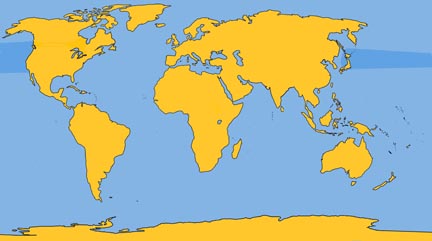Family: Delphinidae
Genus: Lissodelphis
Species: L. borealis (Peale, 1848)
Physically, this animal represents an extreme in aquatic adaptation. While most dolphins have a prominent dorsal fin, fair-sized flippers, and, in general, present a full-bodied appearance, the northern right whale dolphin is the slenderest of all cetaceans and lacks any semblance of a dorsal fin. Its sleekness befits its style of traveling in long, low leaps that only slightly disturb the surrounding water, Primarily black, this animal has a hard-edged, pure white area covering its chest and extending ventrally in a thin white line to its flukes (the white line at the genitals is wider in females than in males). There are many slight color variations within the herds.
As is the case with several other cetacean species, the common name is misleading, for apart from the absence of a dorsal fin it bears no resemblance whatsoever to its namesake, the right whale, and most researchers refer to it as Lissodelphis.
Physical Description: Stocky body. The lower jaw extends slightly ahead of the upper jaw. The throat displays the typical wishbone indentation.
Color: This animal is almost completely black but for the chest and underside, already described. Normally, the animals have a white patch in the vicinity of the lower jaw. The underside of the flukes is white from the tips to near the center. The undersides of the flippers, and occasionally the upper sides as well, are white.
Fins and Flukes: There is no dorsal fin. The small, well-developed flippers are rounded along the leading margins and nearly pointed at the tips. The flukes are very small comparatively, rounded at the tips, with a slight median notch.
Length and Weight: The largest recorded male reached 10 ft. (3 m) in length; the largest female, 7.5 ft. (2.3 m). They reach a weight of about 180 lb. (82 kg).
Teeth: They possess 37 to 43 small, sharply pointed teeth on each side of the upper jaw; 40 to 46 in each side of the lower jaw.
Feeding: They are known to feed on squid and pelagic fish.
Breathing and Diving: Little information available.
Mating and Breeding: Calves of 24 to 28 in. (60 to 70 cm) reportedly are born in April and May and are much lighter in color than adults. Males reach sexual maturity at about 7 ft. (2.1 m); females at about 6.5 ft. (1.98 m).
Herding: They have been observed in groups of up to 2,000 animals.
Distribution: They are found throughout the temperate waters of the North Pacific Ocean from Japan and the Kurile Islands to British Columbia and Baja California.
Migration: They frequent southern California waters from October or November until April. Western North Pacific populations migrate south in autumn or winter to near the southern Kurile Islands.
Natural History Notes: These are avid bow wave riders, making long, low leaps clear of the water as they swim. They are known to associate closely or swim with pilot whales, Risso’s dolphins, Pacific white-sided dolphins, common dolphins, sei whales, humpback whales, gray whales, and California sea lions. Animals with slight color variations found in waters around Japan are occasionally referred to as Lissodelphis borealis albiventris, although this claim is neither widely recognized nor accepted.









